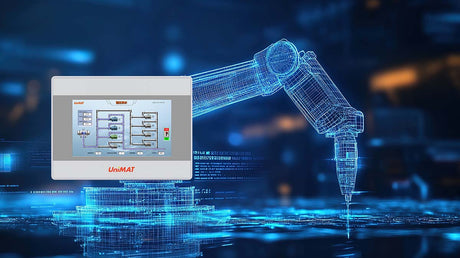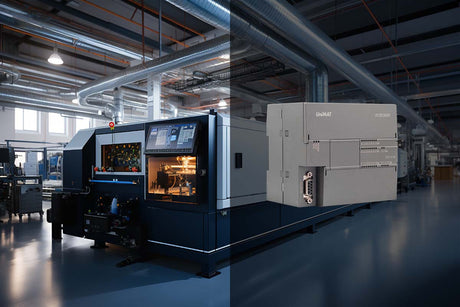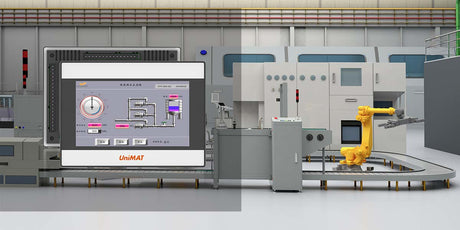Controlador lógico programable , también conocido como controlador lógico programable o PLC para abreviar. Es un dispositivo de sistema electrónico con operación de computación digital basado en un microprocesador, diseñado para aplicaciones en el campo industrial. Los PLC están involucrados en industrias como el acero, la minería, el cemento, el petróleo, la industria química, la electricidad, la fabricación de maquinaria, los automóviles, la carga y descarga, la fabricación de papel, los textiles, la protección del medio ambiente e incluso el entretenimiento en nuestra vida diaria. En resumen, es un controlador comandado por un programa escrito por técnicos electricistas de acuerdo con los requisitos de control de la máquina controlada.
Estructura básica del controlador lógico programable:

01. Módulo CPU
El módulo CPU también se denomina unidad central de procesamiento o controlador y se compone principalmente de un microprocesador (CPU) y una memoria. Se utiliza para ejecutar programas de usuario, monitorear el estado de las interfaces de entrada/salida, realizar juicios lógicos y realizar el procesamiento de datos, es decir, leer variables de entrada, completar varias operaciones especificadas por las instrucciones del usuario, enviar resultados al extremo de salida y responder a solicitudes de dispositivos externos (como programadores, computadoras, impresoras, etc.) y realizar varios juicios internos.
02. Módulo de E/S
El módulo de E/S son los ojos, los oídos, las manos y los pies del sistema, y es un puente que conecta el campo externo y el módulo de CPU. El módulo de entrada se utiliza para recibir y recopilar señales de entrada.
03.Fuente de alimentación
El PLC generalmente utiliza una fuente de alimentación de 220 V CA. La fuente de alimentación regulada de CC dentro del PLC proporciona voltaje de CC para los componentes de cada módulo.
04.Editor
El programador es un dispositivo de programación externo del PLC. Los usuarios pueden ingresar, verificar, modificar, depurar programas o monitorear el estado de funcionamiento del PLC a través del programador. El PLC también se puede conectar a la computadora a través de un cable de programación dedicado, y la computadora se puede programar y monitorear usando software de programación.
05.Unidad de expansión de entrada/salida
La interfaz de expansión de E/S se utiliza para conectar la unidad de expansión que amplía el número de terminales de entrada/salida externos a la unidad básica (es decir, el host).
06. Interfaz de dispositivo externo
Esta interfaz puede conectar dispositivos externos como programadores, impresoras, lectores de códigos de barras e inversores al host para completar las operaciones correspondientes.
Principio de funcionamiento del controlador lógico programable:
El controlador programable tiene dos estados básicos de trabajo, a saber, el estado de ejecución (RUN) y el estado de detención (STOP).
En el estado de ejecución, el controlador programable implementa la función de control ejecutando el programa de usuario que refleja los requisitos de control. Para hacer que la salida del controlador programable responda a la señal de entrada que puede cambiar en cualquier momento, el programa de usuario no se ejecuta solo una vez, sino que se ejecuta repetidamente hasta que el controlador programable se detiene o cambia al estado de trabajo STOP.
Además de ejecutar el programa de usuario, el controlador programable debe completar el procesamiento interno, el procesamiento de comunicación y otras tareas durante cada ciclo. Un ciclo se puede dividir en 5 etapas.
En la etapa de procesamiento interno, el controlador programable verifica si la CPU y el hardware dentro del módulo son normales, reinicia el temporizador de monitoreo y completa algún otro trabajo interno.
En la etapa de servicio de comunicación, el controlador programable se comunica con otros dispositivos inteligentes con microprocesadores, responde a los comandos escritos por el programador y actualiza el contenido de la pantalla del programador.
En la etapa de procesamiento de entrada, el controlador programable lee el estado de encendido/apagado de todos los circuitos de entrada externos en el registro de imagen de entrada.
En la etapa de ejecución del programa, incluso si cambia el estado de la señal de entrada externa, el estado del registro de imagen de entrada no cambiará en consecuencia. El estado cambiado de la señal de entrada solo se puede leer en la etapa de procesamiento de entrada del siguiente ciclo de escaneo.
En la etapa de procesamiento de salida, la CPU transmite el estado de encendido/apagado del registro de imagen de salida al pestillo de salida.

Características del controlador lógico programable:
Alta confiabilidad, fuerte capacidad antiinterferencias.
General y flexible
Programación sencilla y cómoda
Funciones completas, fuerte capacidad de expansión.
Ciclo corto de diseño, construcción y depuración, fácil mantenimiento.
Debido a las características anteriores del PLC, el rango de aplicación del PLC es extremadamente amplio. Se puede decir que mientras haya una fábrica y exista un requisito de control, habrá una aplicación de PLC.









